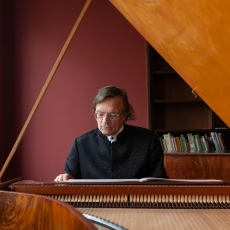Jos van Immerseel - Piano Works of the Young Beethoven - Gramophone
Few keyboard players are able to match the Beethoven credentials of the Belgian conductor and fortepianist Jos van Immerseel, who turns 75 this autumn. Pride of place belongs to his complete Beethoven symphonies with Anima Eterna Brugge (ZZT/Alpha, 6/08), which still stands as a benchmark among original-instrument recordings. Immerseel has also recorded the five piano concertos with Tafelmusik under Bruno Weil (Sony) and huge chunks of the chamber repertory, including two traversals of the piano and violin sonatas, with Jaap Schröder (DHM) and Midori Seiler (ZZT, 11/12) respectively, trios with Vera Beths and Anner Bylsma (Sony), not to mention a miscellany of solo piano pieces. Immerseel’s new three-disc release on Alpha focuses on solo music by Beethoven written between 1798 and 1804, played on a replica of an 1800 Walter piano built by Christopher Clarke in 1988.
There are some genuine interpretative gems here. In the Moonlight Sonata, for instance, the Adagio sostenuto is nothing short of breathtaking, with the indication senza sordino (without dampers) scrupulously observed, creating an ethereal aura of impenetrable mystery that simply can’t be achieved on a modern instrument. If the subsequent folk-inflected Allegretto seems a little genteel, the Presto agitato finale roils and erupts with fine passion and sustained drama.
The Pastoral is another beautifully realised conception, with the piano’s sonorities skilfully exploited to aid and abet the character of the music at every turn. The opening movement fairly breathes the Viennese countryside, while the Andante is haunted by ambiguity. The droll Scherzo precedes a satisfying Rondo that gently sums up with a prescience suggesting Schumann.
The Marcia funebre sulla morte d’une Eroe is excerpted from Op 26 as a stand-alone, progressing with a fine solemnity that aptly evokes the massed occasions of public mourning familiar from 19th-century imagery. The tremolandos of the Trio seem the perfect equivalent of cloth-covered drums typical of such occasions.
Indeed, throughout the set, it is the slow movements that are most captivating. The opening of the C minor Sonata (Op 10 No 2) is closer to an Allegretto con prudenza rather than the Allegro con brio indicated. But stick with it and the spacious Adagio molto that follows is thoroughly convincing indeed. The pattern tends to prevail. In the great D major Sonata, Op 10 No 3, as well as in the two Op 14 Sonatas, the slow movements eloquently penetrate the crux of the matter, while the quicker outer movements, whether held at an arm’s contemplative distance or simply becalmed, seem either enervated or having lost their way.
All told, this is an interesting set, providing intelligent insights and provocative points of view in familiar music played on an instrument similar to that for which it was written.

